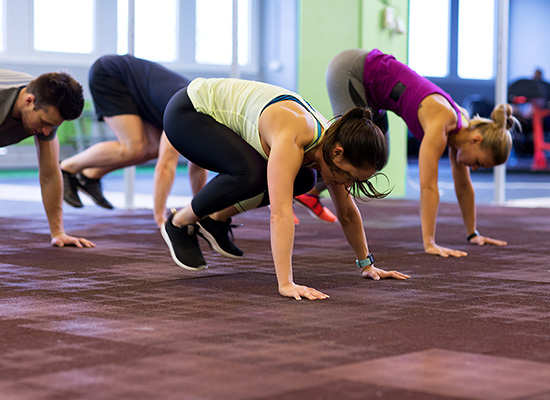Posted by
Lynne Skilton-Hayes
High-intensity interval training (HIIT) continues to be a staple in group fitness classes. A high-intensity bout of work followed by a short rest period, repeated several times, gets results—and everyone likes results! How can you take your knowledge of this format to the next level for your participants? Brush up on your understanding of HIIT and how to implement it for the best possible outcome.
The Benefits of HIIT
One of the main benefits of HIIT is efficiency, especially for those with busy schedules. Finding enough time to meet weekly exercise recommendations can be a challenge. HIIT allows clients to get more done in less time, offering them more bang for their buck. HIIT typically involves short bursts of intense exercise (≥90% of maximal aerobic capacity) interspersed with breaks of varying lengths (Boutcher 2011; Kessler, Sisson & Short 2012).
Immediate responses to a HIIT workout include
- an increase in lactate levels, up to 10 times above baseline;
- increased levels of free fatty acids and blood glycerol, which suggest an early breakdown of triglycerides;
- a steady decline in adenosine triphosphate (ATP) and phosphocreatine, used to meet the rapid-fuel needs of contracting muscles;
- an increase in growth hormone, up to 10 times above baseline; and
- enhanced venous blood flow to the heart, which increases stroke volume.
Sources: Boutcher 2011; Kravitz 2014.
Research on the Benefits of HIIT
A comprehensive HIIT research review found that healthy young and older men and women can improve VO2 max by 4%–46% in training periods lasting 2–15 weeks (Boutcher 2011).
What does this research mean for your group classes? It means you have science behind the methods that you teach and that you are helping people to reach their goals efficiently.
HIIT Recommendations
For the purposes of teaching HIIT in a group setting, it’s important to consider a few basic recommendations:
- Generally speaking, people should have about 3 months of experience with cardiovascular training before beginning HIIT.
- If participants are performing HIIT correctly (intensely), they should do it only about two or three times per week. Since exercise intensity and duration are inversely related, it’s best to keep the duration to 20–30 minutes (or less, in some cases) to decrease injury risk.
- Safety is paramount. Many HIIT workouts include multijoint, compound exercises. It’s important to provide alternative movements to those who are less skilled. Technique and quality should always take precedence over volume or number of reps.
- Movement preparation is imperative. The warmup should include exercises that take the body through all planes of motion, and there should be opportunities to practice major joint movements you plan to do in the workout.
- Recovery is essential. The HIIT sets in the “Sample HIIT Class,” below, include a longer work period, but once a set is over, the rest period lasts 2–4 minutes.
Apply Your HIIT Knowledge
When you combine research with your existing teaching skills, magic happens in the fitness studio. HIIT is a perfect format to stimulate results while keeping people interested and coming back for more. Brush up on your understanding of HIIT and then offer creative class experiences.
Sample HIIT Class
There are many different HIIT formats to choose from, all of which can yield great results. This 30-minute sample class includes a few “mini templates.” A note about intensity: It’s relative to the individual. One person’s “breathless” may be another person’s “moderate.” When cueing the hardest parts of this workout, encourage attendees to push to their individual maximum, whatever that may be.
Warmup
Spend at least 5 minutes preparing the body for the workout. Here are some ideas:
- body-weight squats
- inchworms
- “Frankenstein” kicks
- side lunges
- arm circles
- reverse lunges
Main Workout: Sets 1-3
Set One: 30/20/10 (in seconds) (moderate/hard/hardest) = 1 minute of work
- Squat, 30 seconds (moderate).
- Hold squat and pulse, for 20 seconds (hard).
- Jump squat, 10 seconds (hardest). Keep knees bent and stay low while feet come off the ground.
Rest, for 1 minute.
Set Two: 30/20/10 (moderate/hard/hardest) = 1 minute of work
- Hold squat, keep feet flat on the floor, and press knees out, for 30 seconds (moderate).
- Hold squat at the bottom, for 20 seconds (hard).
- Jump squat, trying to get as high as possible, crossing your feet at top of the movement. Absorb landing by slightly bending knees, 10 seconds (hardest).
Rest, for 2 minutes.
Set Three: as many good reps as possible (AMGRAPS)
Focus on quality movements with a shorter work bout. These sets can be
- timed: 45/15; 50/10; 30/30, etc., or
- repetition-based: Complete 10 reps and then move on.
Sets 4-5
For this example, we’ll go with two rounds of 45/15, with 1-minute rest between rounds, for 13 minutes total.
- Hook, slip, hook, slip: With left foot forward, hook with L arm. Elbow leaves the side of the body as the torso rotates. The hand stops just past the opposite side; the arm is parallel to the floor. Use oblique on the punching side to pull the arm back in place (the “slip”). Repeat.
- Side plank with hip flexion/extension: Hold an elbow side plank, either on the knees or feet. Keep your body perfectly still as you move your top leg forward and back.
- Drop pushup: Start in side plank, hand and feet on the ground. Rotate toward the floor and, as second-hand touches, the ground, bend your elbows and drop into a pushup. Press up, ending in a side plank on the opposite side; reverse direction to repeat.
- Lateral skater, single-leg jump: Do alternating side-to-side skaters, 3x. On the third one, jump once, outside leg only. Slightly bend your knee to absorb the landing.
- Hook, slip, hook, slip: Repeat the first move of the set, right side.
- Side plank with hip flexion/extension: Repeat the second move, opposite side.
Rest, for 2 minutes.
Set Four: hard/harder/hardest, 20 seconds each
- Deep lunge: Start with the back knee on the floor, ensuring the front knee is at 90 degrees. Stand up, extending both knees.
- Pulse lunge, lifting back leg only. Arms punch up and down.
- Power lunge: Have both feet leave the ground, both arms punching.
Rest, for 2 minutes.
Set Five: Tabata, 20 seconds “all out,” 10 seconds rest, 8x, 4 minutes total
- Sets 1, 3, 5 and 7: Do jumping jacks with speed (air jacks). Spend as little time on the ground as possible. When your feet come off the floor, circle your arms back. Complete as many as possible in 20 seconds.
- Sets 2, 4, 6 and 8: Jab, jab, hook. Arm extends straight out, palm down, elbow extended, aiming at a target in line of sight. Punch right/left/right and then left/right/left.
Rest, for 2 minutes.
Cooldown
(5 minutes)
Spend the last few minutes bringing down heart rates and transitioning into stillness. Take the class through a total-body stretch and recovery, using the following ideas as inspiration.
- triceps and shoulder stretches
- wide-legged forward fold, hands interlaced behind back
- runner’s lunge/quadriceps stretch
- downward-facing dog
- child’s pose
Learn How to Master Interval Training in Indoor Cycling Classes
Many indoor cycling classes focus on high-intensity interval training, due to its many benefits, most notably time efficiency. However, when overdone or used in the wrong way, HIIT can increase injury risk and diminish the exercise experience for some participants.
AFAA’s new G.E.A.R. Indoor Cycling Instructor Certification teaches key HIIT principles and how to apply them to this training method while providing a better understanding of appropriate interval intensities, recovery ratios and training loads. As a result, you will be able to design classes that use (but do not abuse) this popular training method to deliver a safe, results-oriented experience.
References
Boutcher, S.H. 2011. High-intensity intermittent exercise and fat loss. Journal of Obesity, doi: 10.1155/2011/868305.
Kessler, H.S., Sisson, S.B., & Short, K.R. 2012. The potential for high-intensity interval training to reduce cardiometabolic disease risk. Sports Medicine, 42 (6), 489–509.
Kravitz, L. 2014. Metabolic effects of HIIT. Accessed Apr. 1, 2020: ideafit.com/group-fitness/metabolic-effects-of-hiit/.
Swain, D.P., & Franklin, B.A. 2006. Comparison of cardioprotective benefits of vigorous versus moderate intensity aerobic exercise. American Journal of Cardiology, 97 (1), 141–47.
Topics: Group Fitness, HIIT

About the Author:
Lynne Skilton-Hayes is an international fitness presenter and fitness program supervisor at the University of Guelph in Guelph, Ontario. She brings more than 24 years of education and experience to the fitness industry. Skilton-Hayes is a canfitpro PRO TRAINER and Matrix master trainer and was awarded the prestigious YMCA Woman of Distinction award in 2017

